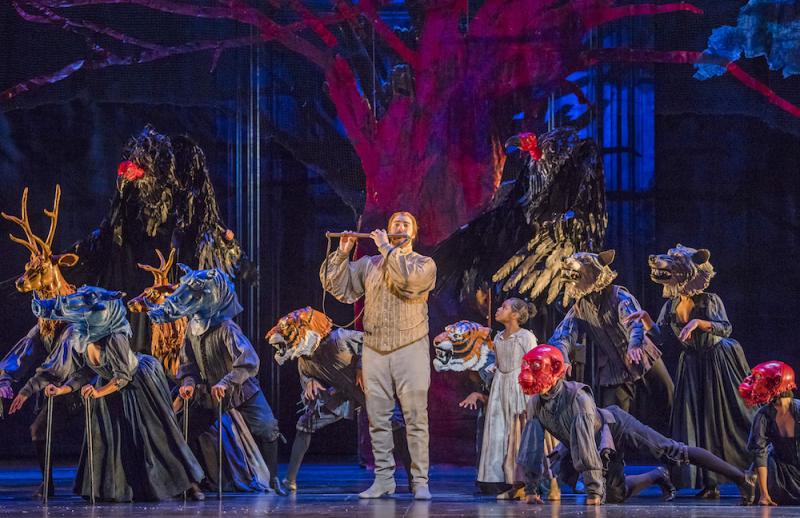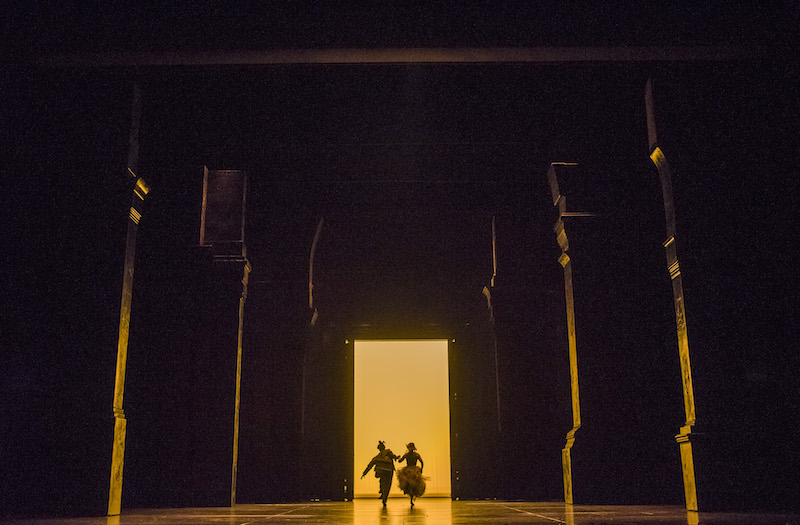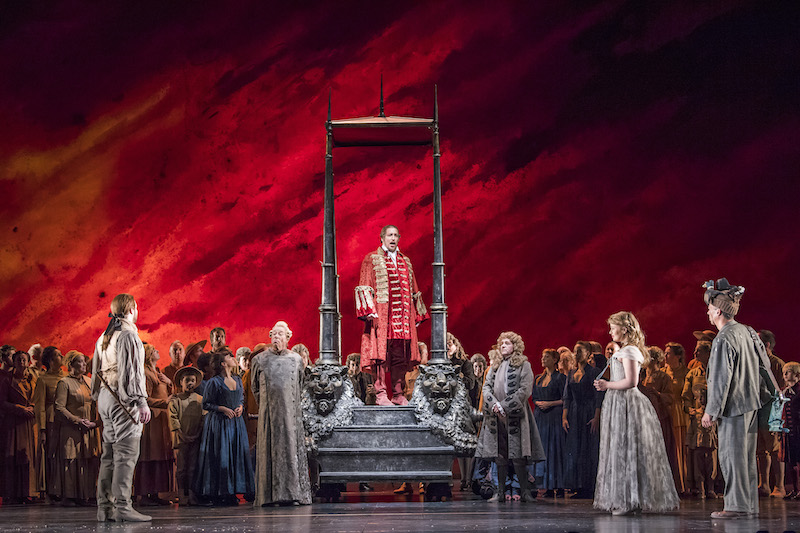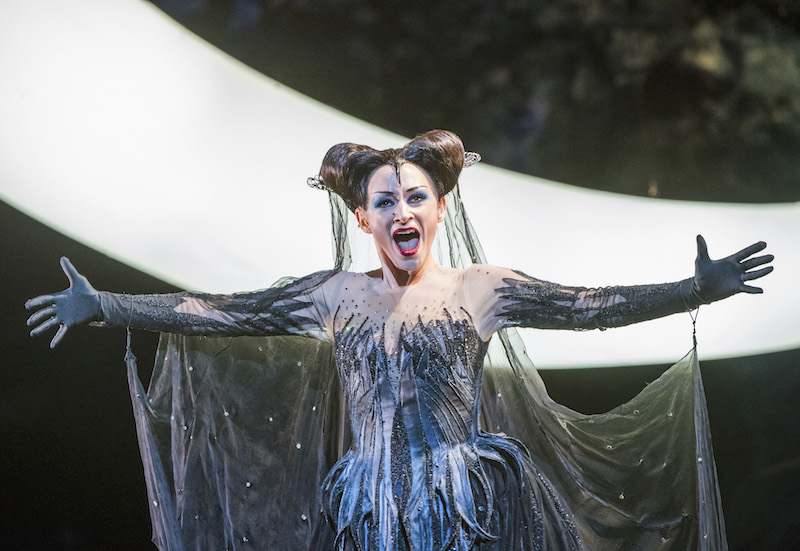Die Zauberflöte, Royal Opera review – enjoyable revival of much loved production | reviews, news & interviews
Die Zauberflöte, Royal Opera review – enjoyable revival of much loved production
Die Zauberflöte, Royal Opera review – enjoyable revival of much loved production
Mozart’s evergreen crowd-pleaser boasts striking visuals and impressive singing

This is the sixth revival of David McVicar’s production of Die Zauberflöte at Covent Garden since its debut in 2003. It was heard most recently in 2015, and is modestly described in the Royal Opera’s own publicity as a “classic”.
Last year, Alexandra Coghlan for theartsdesk found Simon McBurney’s production at English National Opera to be “revelatory” in its inventive theatricality. Here McVicar, and revival director Thomas Guthrie, dip their toe in these waters with the giant puppet snake that starts the opera, and the masked animals dancing weirdly when Tamino plays the flute in Act One. But for the most part the staging is fairly traditional and perhaps a touch tame, when set against the ambition of the set design. The set is grandiose, all dark marble columns that loom in and out, with occasionally colourful backdrops: a bright yellow sun in the finale, a red sky behind Sarastro’s first entrance, a craggy blue for the Queen of the Night (a stern Sabine Devieilhe). The costumes are mostly muted colours, the lighting mostly low. But all this seems somehow at odds with the colourful exuberance of so much of the music, and the artless folk-like melodies that predominate.
The set is grandiose, all dark marble columns that loom in and out, with occasionally colourful backdrops: a bright yellow sun in the finale, a red sky behind Sarastro’s first entrance, a craggy blue for the Queen of the Night (a stern Sabine Devieilhe). The costumes are mostly muted colours, the lighting mostly low. But all this seems somehow at odds with the colourful exuberance of so much of the music, and the artless folk-like melodies that predominate.
I would not be the first to observe that the story is the sheerest nonsense, cobbled together from disparate sources by the entrepreneur and original Papageno, Emanuel Schikaneder. The spoken dialogue (delivered here in German) is comic, but at times the audience, especially in the first half, seemed to be laughing rather dutifully. The second half provoked more spontaneous laughs, Roderick Williams as Papageno channelling his inner Stan Laurel. The slapstick, and attempts at audience interaction, are broad, but engaging and funny.
The singing was (almost) uniformly excellent. For me the standout moments were the bass arias for Sarastro (Royal Opera debutant Mika Kares) in Act Two. In “O Isis und Osiris” in particular he was rich and resonant, a proper bass for a proper bass aria. Kares (pictured above) had a statuesque authority in the role that contrasted well with Williams’s foolish but well-meaning Papageno. I must praise the Three Boys, James Fernandes, Oliver Simpson and Jayden Tejuoso, whose singing was crystal clear and had evident enjoyment in their appearances.
Devieilhe as the Queen of the Night (pictured below) gave a coldly furious “Der hölle Rache” that had sufficient wow factor, and made up for a slightly imprecise Act One aria. Mauro Peter, another Royal Opera debutant, had no difficulty filling the stage as Tamino. Siobhan Stagg’s Pamina was an assertive heroine, but also affecting in her Act Two misery, floating high notes with the utmost control. It was notable that the libretto’s more problematic sexist lines – “women do little and talk a lot” or “without a man, a woman cannot fulfil her destiny” – were greeted with laughter from the audience. There is no need to rail against these offences to modern sensibility: derision is a much more powerful response. And Mozart’s musical depiction of Pamina as a strong woman is likewise.
It was notable that the libretto’s more problematic sexist lines – “women do little and talk a lot” or “without a man, a woman cannot fulfil her destiny” – were greeted with laughter from the audience. There is no need to rail against these offences to modern sensibility: derision is a much more powerful response. And Mozart’s musical depiction of Pamina as a strong woman is likewise.
The conductor Julia Jones maintained steady tempos and the orchestra were poised and controlled, never anything less than refined, but never pushing the boat out. The horns sounded terrific as did, fittingly, flautist Danuel Pailthorpe.
This production is visually very striking and beautiful to look at. It was also good to listen to. But although I did enjoy it a great deal – and the evening did go past very quickly – in the end I was left wondering if there was quite enough magic in this Magic Flute.
Add comment
The future of Arts Journalism
You can stop theartsdesk.com closing!
We urgently need financing to survive. Our fundraising drive has thus far raised £49,000 but we need to reach £100,000 or we will be forced to close. Please contribute here: https://gofund.me/c3f6033d
And if you can forward this information to anyone who might assist, we’d be grateful.

Subscribe to theartsdesk.com
Thank you for continuing to read our work on theartsdesk.com. For unlimited access to every article in its entirety, including our archive of more than 15,000 pieces, we're asking for £5 per month or £40 per year. We feel it's a very good deal, and hope you do too.
To take a subscription now simply click here.
And if you're looking for that extra gift for a friend or family member, why not treat them to a theartsdesk.com gift subscription?
more Opera
 La bohème, Opera North review - still young at 32
Love and separation, ecstasy and heartbreak, in masterfully updated Puccini
La bohème, Opera North review - still young at 32
Love and separation, ecstasy and heartbreak, in masterfully updated Puccini
 Albert Herring, English National Opera review - a great comedy with depths fully realised
Britten’s delight was never made for the Coliseum, but it works on its first outing there
Albert Herring, English National Opera review - a great comedy with depths fully realised
Britten’s delight was never made for the Coliseum, but it works on its first outing there
 Carmen, English National Opera review - not quite dangerous
Hopes for Niamh O’Sullivan only partly fulfilled, though much good singing throughout
Carmen, English National Opera review - not quite dangerous
Hopes for Niamh O’Sullivan only partly fulfilled, though much good singing throughout
 Giustino, Linbury Theatre review - a stylish account of a slight opera
Gods, mortals and monsters do battle in Handel's charming drama
Giustino, Linbury Theatre review - a stylish account of a slight opera
Gods, mortals and monsters do battle in Handel's charming drama
 Susanna, Opera North review - hybrid staging of a Handel oratorio
Dance and signing complement outstanding singing in a story of virtue rewarded
Susanna, Opera North review - hybrid staging of a Handel oratorio
Dance and signing complement outstanding singing in a story of virtue rewarded
 Ariodante, Opéra Garnier, Paris review - a blast of Baroque beauty
A near-perfect night at the opera
Ariodante, Opéra Garnier, Paris review - a blast of Baroque beauty
A near-perfect night at the opera
 Cinderella/La Cenerentola, English National Opera review - the truth behind the tinsel
Appealing performances cut through hyperactive stagecraft
Cinderella/La Cenerentola, English National Opera review - the truth behind the tinsel
Appealing performances cut through hyperactive stagecraft
 Tosca, Royal Opera review - Ailyn Pérez steps in as the most vivid of divas
Jakub Hrůša’s multicoloured Puccini last night found a soprano to match
Tosca, Royal Opera review - Ailyn Pérez steps in as the most vivid of divas
Jakub Hrůša’s multicoloured Puccini last night found a soprano to match
 Tosca, Welsh National Opera review - a great company reduced to brilliance
The old warhorse made special by the basics
Tosca, Welsh National Opera review - a great company reduced to brilliance
The old warhorse made special by the basics
 BBC Proms: The Marriage of Figaro, Glyndebourne Festival review - merriment and menace
Strong Proms transfer for a robust and affecting show
BBC Proms: The Marriage of Figaro, Glyndebourne Festival review - merriment and menace
Strong Proms transfer for a robust and affecting show
 BBC Proms: Suor Angelica, LSO, Pappano review - earthly passion, heavenly grief
A Sister to remember blesses Puccini's convent tragedy
BBC Proms: Suor Angelica, LSO, Pappano review - earthly passion, heavenly grief
A Sister to remember blesses Puccini's convent tragedy
 Orpheus and Eurydice, Opera Queensland/SCO, Edinburgh International Festival 2025 review - dazzling, but distracting
Eye-popping acrobatics don’t always assist in Gluck’s quest for operatic truth
Orpheus and Eurydice, Opera Queensland/SCO, Edinburgh International Festival 2025 review - dazzling, but distracting
Eye-popping acrobatics don’t always assist in Gluck’s quest for operatic truth

Comments
The flautist in Magic Flute
Amended, with thanks.
Amended, with thanks.